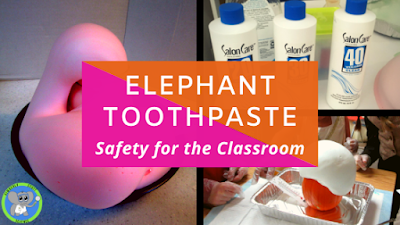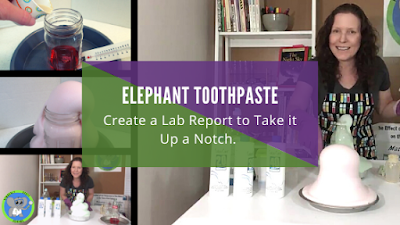Pumpkin Themed Elephant Toothpaste Classroom Lab Experiment
One of the most exciting chemical reactions to try out during Halloween is Elephant Toothpaste. I personally find this experiment to be a more advanced version of the classic vinegar and baking soda reaction. While vinegar and baking soda are still great, taking things to the next level is always fun.
Pumpkin Themed Elephant Toothpaste is a great science activity and perfect for a class party. Instead of doing the typical crafts and bingo, pull out the safety goggles and gloves and make erupting pumpkins. The kids will have a blast! All you do is use pumpkins instead of containers. The below pictures show pie pumpkins. They are inexpensive and the perfect size. See directions and tips below.
What Makes it Special?
What is happening?
This reaction involves using hydrogen peroxide. The chemical formula is H202. We are most used to the chemical formula of water (H20). That extra oxygen on H202 is a weak bond. It is very fragile and will easily separate, becoming H20 and 0. That is why you need to keep H202 stored properly. Elephant toothpaste happens when we speed up the reaction. We can speed up the reaction by using a catalyst.The purpose of a catalyst is to speed up the breakdown of molecules into simpler parts. The catalyst used in this experiment is yeast. Yeast are living organisms with enzyme catalysts that quickly break hydrogen peroxide into water molecules and oxygen atoms. We add soap to elephant toothpaste to make it foamier.
In this experiment, the yeast must be activated by placing it in warm water. The warm water will take the yeast out of the dormant state. The magic happens once the yeast water mixture is poured in with the soapy hydrogen peroxide. The oxygen atom will separate from the hydrogen peroxide, mix with the now soapy water, and rise out of the container. When the bond breaks, heat will be given off. You can take the water temperature before the experiment and the foam after to see the temperature rise. You can also touch it to feel the warmth. Please wear gloves to be extra safe.
What kind of hydrogen peroxide should I use?
Safety
Goggles and gloves must be worn during the experiment. Hydrogen peroxide can be irritating to the skin. After the experiment, you will have a mixture of soapy water with yeast. Students can touch that with their hands. It is a warm, fluffy foam. Be careful of spills, and look at your students' abilities before beginning.Explore, Investigate, Discover
Here is a great activity for students to explore the reaction further. Students will investigate elephant toothpaste by following the scientific method. They will answer the question: Does increasing the concentration of hydrogen peroxide affect the temperature of elephant toothpaste? Students will explore further by creating their own elephant toothpaste investigation.
This can be completed as a class, in groups, or as a science fair project. The journal will take you step by step through the process. It also includes an elephant toothpaste assessment. This is a great way to meet the standards.
SHOP THIS POST
LEARN MORE



)%20(1).png)




